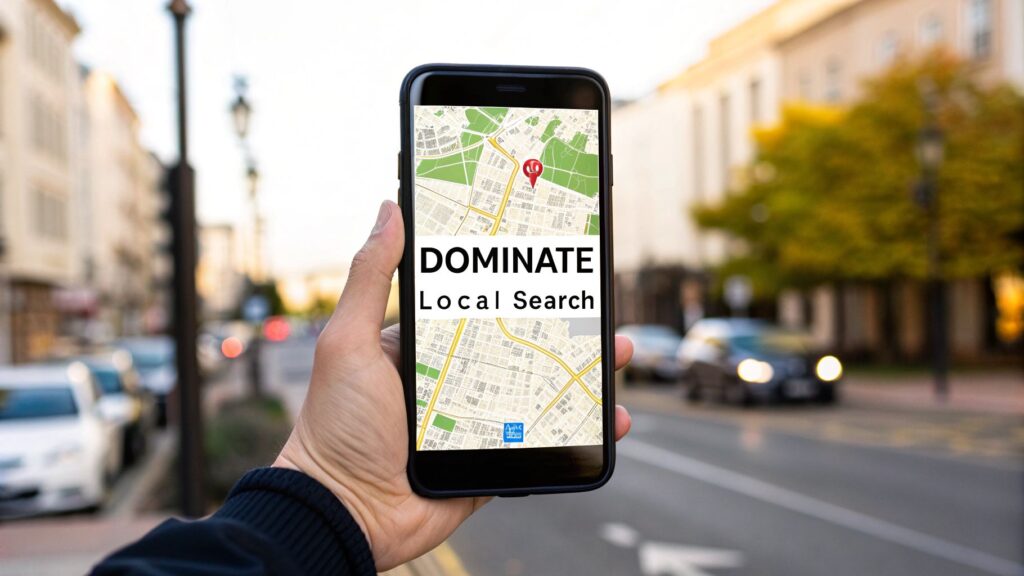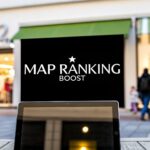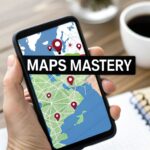You can have the most breathtaking portfolio in the world, but if nobody sees it, it won’t book you any clients. That’s where Search Engine Optimization (SEO) comes in. It’s the bridge connecting your stunning work with people actively searching on Google for a photographer exactly like you.
When we talk about the best seo for photographers, we’re focusing on a few key areas. This includes mastering local search to connect with nearby clients, optimizing your images so they load fast and appear in searches, and creating content that helps the clients you want to attract.
Why SEO is a Non-Negotiable for Your Photography Business
Think about it from your client’s point of view. When a newly engaged couple starts planning their wedding, one of the first things they do is head to Google.
It's not a guess—data shows that a huge 73% of couples use Google to find their wedding vendors. If your website is buried on page five of the search results, you're invisible to a massive number of potential clients who are ready to book.
In Short: A smart SEO strategy isn't about tricking Google; it's about making your website the most helpful and relevant result for what your ideal client is searching for.
The Real Goal of SEO for Your Business
Good SEO isn't just about driving random traffic to your site. The goal is to attract the right visitors—the people who love your style and are looking for exactly what you offer.
A well-optimized website does more than just climb the rankings. It builds your credibility before a client even sends an email. Imagine someone finds your blog post about the "best elope-spots in Colorado." You're no longer just another photographer; you're the local expert.
Key Takeaway: Think of SEO as a long-term investment. Unlike paid ads that vanish when you stop paying, solid SEO builds a steady, sustainable stream of high-quality inquiries that grows over time.
By focusing on a few key strategies, you can transform your website from a quiet online gallery into a tool that consistently brings in new clients. Our complete guide to SEO for photographers dives deep into this. We’ll walk you through everything from keyword research to local search tactics you need to stand out.
Finding Keywords That Attract Your Dream Clients

Let's talk about keywords. They are just the words and phrases your ideal clients are typing into Google. The secret isn't finding any keywords; it’s about finding the ones that lead the right people to your portfolio.
Forget trying to rank for a broad term like "photographer." Sure, it gets tons of searches, but most of those people aren't ready to hire you.
Instead, we need to get specific with long-tail keywords. Think of these as descriptive phrases that reveal exactly what someone wants.
Moving Beyond Generic Searches
Consider the searcher's mindset. Someone typing "photographer" is probably just browsing. But someone typing "moody outdoor wedding photographer in Austin"? That person knows what they want and is likely ready to book.
By targeting these longer, more specific phrases, you put yourself in front of people who are much closer to making a decision. You're not just a photographer; you're the solution to their specific need.
Here are a few real-world examples:
- "Candid family photoshoots Central Park"
- "Affordable newborn photographer Brooklyn"
- "Documentary-style elopement photographer Pacific Northwest"
- "Best locations for engagement photos in Chicago"
See the difference? These keywords show clear intent. This is the heart of what makes for the best SEO for photographers—it's all about attracting quality leads, not just high traffic.
The Bottom Line: Focusing on specific, long-tail keywords brings people to your site who are much more likely to book because you're already a perfect match for what they were looking for.
How to Actually Find These Keywords
You don't need expensive software to start. The best first step is to get inside your client's head. If you were them, what would you type into Google to find a photographer like you?
Effective SEO for photographers hinges on this simple idea: use the exact language your clients use. For a deeper dive, check out this guide on how photographers can use keywords from blog.topicranker.com.
Once you have some ideas, go to Google. Type in one of your phrases and scroll down to the "People Also Ask" section. This is a goldmine for blog post ideas, FAQ pages, and new keywords you hadn't considered.
How To Optimize Your Images Without Sacrificing Quality

As photographers, our images are the business. They're our portfolio and our product. But here’s the truth: gorgeous, high-resolution files can absolutely tank your website's performance.
Large, unoptimized images are the #1 killer of site speed for photographers. And a slow site is an SEO death sentence.
The good news? You don’t have to choose between beautiful images and a fast website. Image optimization is a key part of the best SEO for photographers because it improves user experience and signals to Google that your site is a professional resource.
File Format and Size: The Foundation of Site Speed
Before you hit "upload," the most critical decisions are about file type and size.
-
Choose the Right Format: For most photos, JPEG is your best bet. It offers a great blend of quality and compression. Modern formats like WebP are even better, often delivering a 25-35% smaller file size with no visible quality loss. Tools like ShortPixel or Imagify can convert your JPEGs to WebP automatically.
-
Get the Sizing Right: Never upload a full-resolution photo from your camera. A 5000-pixel wide image is overkill for a blog post that only needs an 800-pixel wide photo. Resize your images to the exact dimensions they will appear on your site.
-
Always Compress: This is the magic step. Compression strips out unnecessary data to shrink the file size. Tools like TinyPNG can slash file sizes by over 70% without a noticeable difference. Aim for image file sizes under 200kb whenever possible.
My Pre-Upload Workflow: It’s a simple two-step process. First, I resize the dimensions. Second, I run it through a compression tool. This ensures my images are lean without compromising quality.
Writing File Names and Alt Text That Help You Rank
Image optimization isn't just about speed; it's also a creative SEO task. Search engines are smart, but they can't "see" a photo and understand its context. We have to tell them.
Image File Names
Your camera probably creates files named _DSC8412.jpg. To Google, that's meaningless. Renaming your files with descriptive, keyword-rich names before you upload is a simple but powerful SEO win.
- Don't do this:
IMG_1234.jpg - Do this instead:
moody-portland-elopement-couple-on-coast.jpg
Use dashes to separate words. Think about what a client might search for and include it in the file name. This helps your images show up in Google Image Search.
Alt Text (The Secret SEO Weapon)
Alt text (alternative text) describes an image for accessibility and SEO.
- What is it for? It’s a written description of the photo for people who can't see it, like those using screen readers.
- How does it help SEO? A great alt text naturally includes your target keyword and provides context for Google. For example: "A newlywed couple embraces during their moody Portland elopement on the Oregon coast."
- How do you write it? Be descriptive but don't stuff it with keywords. Write for a human first, Google second.
Your Quick-Reference Image SEO Checklist
Follow these steps for every photo you upload. This boosts your SEO and site speed without compromising image quality.
| Optimization Task | What to Do | The SEO Benefit |
|---|---|---|
| Descriptive File Name | Rename the file from _DSLR987.jpg to keyword-rich-description.jpg before uploading. |
Tells Google what the image is about before it even analyzes the page. |
| Resize Dimensions | Scale the image down to the exact size it will be displayed on the page (e.g., 1200px wide). | Drastically reduces the initial file size, making the page load much faster. |
| Compress the File | Use a tool like TinyPNG or ShortPixel to reduce the file size, aiming for under 200kb. | Significantly improves your page load speed, which is a major ranking factor. |
| Choose the Right Format | Use JPEG for most photos or WebP for the best quality-to-size ratio. | Modern formats serve high-quality images at smaller file sizes, boosting performance. |
| Write Great Alt Text | Add a descriptive alt text that explains the image, including keywords naturally. | Improves accessibility and gives search engines crucial context to rank your image. |
Mastering Local Search to Get More Bookings
Here’s a truth for most photographers: your next client is probably right around the corner. Mastering local SEO is your secret weapon. It’s all about putting your business in front of people in your city who are searching for a photographer right now.
In Short: Getting local SEO right means a steady stream of local inquiries hitting your inbox.
The centerpiece of this strategy is your Google Business Profile (GBP). This free listing is what gets you into the Google Maps "map pack" when someone searches "wedding photographer near me." Think of your GBP as your digital storefront.
Optimizing Your Google Business Profile
Just claiming your profile isn't enough. You have to fill out every single section to give Google a clear picture of who you are and what you do.
Let's break it down:
- Business Categories: Choose "Photographer" as your primary category. Then, get specific with secondary ones like "Wedding photographer" or "Portrait studio."
- Service Areas: This is huge. Clearly define the cities and neighborhoods you serve. This tells Google exactly where to show your profile.
- Photos and Videos: This is your domain! Upload high-quality, professional shots of your work and a friendly headshot. Pro tip: Geotag your photos with location data before you upload them for extra local relevance.
- Services: Don't just list "photography." Spell it all out. List every service you offer, from engagement sessions to headshots, each with a brief description.

As you can see, great alt text starts with a good keyword, adds descriptive context, and keeps it short. This helps search engines understand what's in your photos.
The Power of Reviews and Local Citations
Positive reviews are gold for local SEO. They build trust and are a major ranking factor. Don't be shy about asking happy clients to leave you a review on Google. Make it easy for them by sending a direct link after you deliver their gallery.
Key Insight: Respond to every single review, good or bad. A thoughtful response to a glowing review is great, but a professional reply to a negative one shows you’re an engaged business owner.
Beyond reviews, you need consistent local citations. This just means getting your business's name, address, and phone number (called NAP) listed on other relevant websites like Yelp, The Knot, or local directories. Consistency is key—your NAP must be identical everywhere.
The demand for local services is exploding. If you want to dive deeper, our guide on local maps SEO has even more strategies to help you dominate your local market.
People Also Ask: Your Top SEO Questions

Diving into SEO can feel like learning a new language. I've put together answers to the most common questions I hear from photographers to help you get started.
How do I SEO my photography website?
Optimizing your photography website for SEO involves several key steps. Start by focusing on these three areas:
- On-Page SEO: Target relevant keywords (e.g., "newborn photographer in Brooklyn") in your page titles, headings, and text.
- Image Optimization: Resize, compress, and use descriptive file names and alt text for all your images to improve site speed.
- Local SEO: Create and fully optimize a Google Business Profile to attract clients in your specific service area.
Is photography good for SEO?
Yes, photography is excellent for SEO, but you have to do it right. High-quality images can significantly improve user engagement, which is a positive signal to Google. However, large image files can slow down your site, hurting your SEO. The key is to optimize your images for the web by compressing them and using proper alt text. This allows you to have a visually stunning site that is also fast and search-engine-friendly.
Do photographers really need a blog for SEO?
Yes. A thousand times, yes. A blog is probably the single most powerful SEO tool you have. It's your space to create content that answers the exact questions your ideal clients are typing into Google.
Think of it this way:
- Showcase your latest shoots: Blog a recent wedding, tagging the venue and other vendors.
- Become the local expert: Write a guide like "Top 5 Engagement Photo Spots in Austin."
- Answer client questions: Create a post that breaks down what to wear for a family session.
Every post is a new hook in the water, giving Google another reason to show your site to people. For a deeper dive, our guide on SEO for wedding photographers has great ideas.
The bottom line: A blog isn't just a nice-to-have; it's a core part of a winning strategy for the best SEO for photographers. It helps you rank for more keywords and positions you as the go-to expert.
Can I do SEO myself, or should I hire someone?
You can absolutely get started on your own. By following the advice in this guide—like optimizing your images, beefing up your Google Business Profile, and starting a blog—you can make a massive difference. For most photographers, DIY SEO is a fantastic way to learn.
As your business grows, your time becomes more valuable. That’s when it might make sense to bring in an expert. An SEO pro can handle the more technical aspects and free you up to do what you love most: creating incredible photographs.
At Clicks Geek, we build powerful SEO strategies that turn photographers' websites into client-booking machines. If you're ready to grow your business with a team of experts in your corner, we're here to help. Find out how we can get you more bookings at https://clicksgeek.com.
Is Your Business Ranking in Google Maps?
Turn Google Maps into a Lead Engine w/ Clicks Geek’s AI-powered local SEO. 3,000+ clients served. Our proprietary, fully done-for-you Maps SEO system handles everything—keyword targeting, local optimization, content, reviews, and ranking strategy—automatically.






